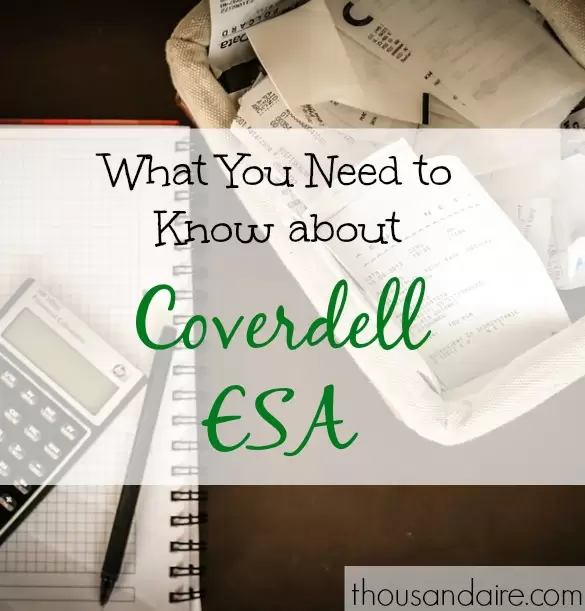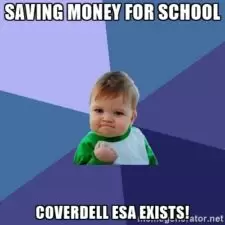 The current tax code is a mishmash of law and loophole that’s been built up over many years. In some cases, like the 401(k) the loophole was later championed by someone and made into real law. If the 401(k) was kind of an accident, the IRA was pretty much on purpose. We’re going to discuss something quite similar for educational savings accounts. The 529 plan is a little more like the 401(k) in this respect. The Coverdell ESA (Educational Savings Account) was a little more on purpose.
The current tax code is a mishmash of law and loophole that’s been built up over many years. In some cases, like the 401(k) the loophole was later championed by someone and made into real law. If the 401(k) was kind of an accident, the IRA was pretty much on purpose. We’re going to discuss something quite similar for educational savings accounts. The 529 plan is a little more like the 401(k) in this respect. The Coverdell ESA (Educational Savings Account) was a little more on purpose.
The History
I’m just kidding. There’s no way you want to know that the Coverdell came out of a big budget reconciliation act in the late 90s. (Also the one that gave 529’s some of their fun tax benefits!) You also probably don’t care that it was named after senator Coverdell. Eh, even reading into this section this far should get you something. Enjoy a video I watched today as a reward:
What’s the Benefit of the Coverdell ESA?
Okay, now we’re getting to the stuff a reasonable person would care about. The entire point of the Coverdell ESA is that it’s basically a Roth for educational expenses rather than retirement.
Let me repeat that. You know the awesome roth thingy?
The one I’m always going on about?
The one we have a video about here?
You can have that for educational expenses.

What are the Limitations for the Coverdell ESA?
Well, bad news first. You can only contribute $2,000 annually to a specific beneficiary. Beneficiaries have to be under 18, so this isn’t a great way to save money for yourself to go back to school. It’s really to save for people roughly the age of the kid photographed above.
Additionally, you can only contribute to a Coverdell ESA if your Modified Adjusted Gross Income is less than $110,000 for individuals and $220,000 for couples filing jointly. If your salary is higher than that, check out our article on how to keep your MAGI reasonable.
The beneficiary also has to use the account for qualified educational expenses before they turn 30. So that means if you’re putting money aside for your kid figuring they’ll go to school, they need to use that money in their 20’s or earlier.
This shouldn’t be too hard unless they’re waiting a real long time to get started with school:

How Do I Deal with the Coverdell ESA limits?
Well, fortunately, you have some options if you have created a Coverdell ESA and it turns out to be a mistake, maybe you contributed more than your kid would end up needing in school.
Maybe your kid got a full scholarship. All kinds of things can happen.
Fortunately, you can change beneficiaries. The new beneficiary has to be a related person. The IRS doesn’t want to create a market for Coverdell ESAs by allowing you to transfer to just anyone.
One major difference between Coverdell ESAs and Roth IRAs is that you can’t just take contributions back out, tax free! This is a big difference in my view, as a major selling point of Roth’s is that you might as well always max it out. After all, if you change your mind you can just take your contributions right back out, no penalties, no questions asked.
For the Coverdell ESA you have to treat each distribution as though the money has been mixed around in the account, and you must pay taxes on a distribution as though it contains representative parts of (non-taxable) contributions and (taxable) earnings.
Best bet with the Coverdell ESA is to only put money in that you’re pretty sure will get used for educational expenses by the beneficiary you have in mind or at least some under 30 relative.
What Expenses Count as Qualified Educational Expenses?
Well, I’m glad you asked. You can get the story straight from the horse’s* mouth here. I’ll give you a broad brush though:
First off, normal living type expenses are NOT qualified educational expenses. Room and Board, medical bills (even if they are charged by your university!) do not count. Nor is the cost of a car to get to school. A short version is, don’t be silly, you know that these things aren’t educational expenses. Don’t be an ass about it.
Tuition and mandatory fees ARE qualified educational expenses…very probably. (I mean probably talk to a real accountant, but I’m pretty sure). Of course, this is kind of the well, duh part. Tuition pays for the education it’s an educational expense, go figure.
Student loans are NOT qualified educational expenses.
I know what you’re thinking. What’s up with that!?
Well, student loans are a way of paying educational expenses, they aren’t educational expenses themselves. That’d be like calling your contributions to an ESA a qualified educational expense.
But what about interest on student loans?? Why isn’t that an educational expense???
Those are deductible anyway (at least I’m pretty sure), so you’re paying them with pre-tax money anyway.
Other expenses can depend, like books and that sort of thing, but the upshot seems to be that any expense required by the school for attendance can be counted as a qualified educational expense. Consult a tax advisor, be realistic.
Disclaimer: I am not a tax advisor. This is not tax advice. I’m not even an accountant. I got a BS in physics. This is for entertainment purposes only. I do not believe the IRS to be made up of horses. Nor do I believe them to be afflicted by the terrible condition known as “horse’s mouth”.
You may want to check out some of our top posts:
Adam Woods is a physicist. His research interests include building software to run and build geomagnetic models. Adam got interested in personal finance in the great recession when it became obvious an interest was necessary.
After harassing his friends and family (and a short intervention) he took to the web where he blogs about finance, investment, politics, and economics.
Adam is currently located in Boulder, Colorado where he can generally be found hiking, biking, or running a D&D campaign. He can also be contacted at adamwoods137@gmail.com.



Just to add, Student loan interest is deductible (up to $2500 in interest per return, whether you file married jointly/single/head of household/qualifying widow(er)) but it does phase out at higher incomes and you can’t file married filing separately.
This is important! Student loan interest deductions phase out! Thanks for noting that Emily.
So I have no young ones to worry about their education and if things go as planned we won’t. I do have plenty of nieces and nephews that I hope have these set up for them but in the end that’s not really my concern. Great informative article though, made a serious dry subject enjoyable thanks for this.
Well, I know that Kevin (the original writer for this site) had some strong opinions about toys and games vs 529/Coverdell contributions: https://www.thousandaire.com/stop-buying-stupid-toys-and-open-a-529/
$36,000 doesn’t seem like it would get most people very far. I mean, it is growing tax free for a number of years, but still, that $2,000 cap is pretty ridiculous.
Well, the first $2,000 you put in might compound to as much as $8,000 by the kid’s 18th birthday, but you’re absolutely right, it’s not much. Fortunately, you can also contribute to 529 plans! I view this as more of a supplement than a complete savings plan for your kids education, though depending on the school they go to you might end up with plenty of money by the time they graduate high school.